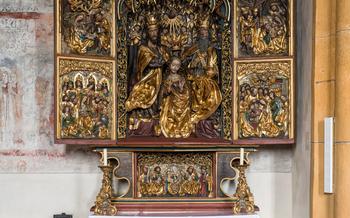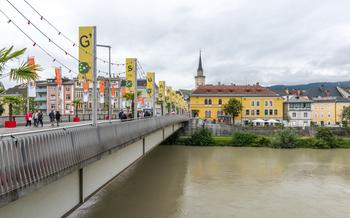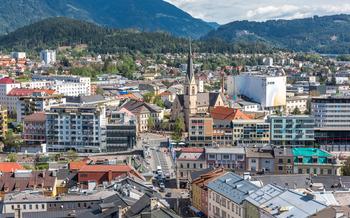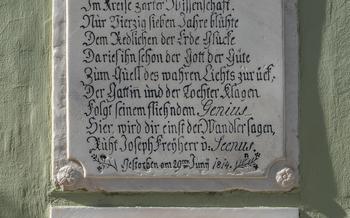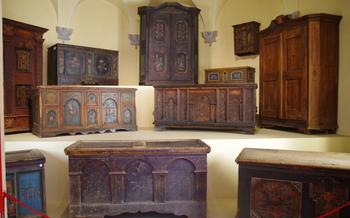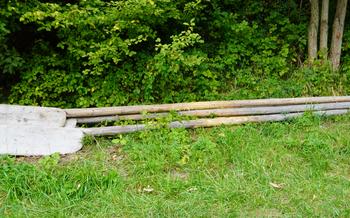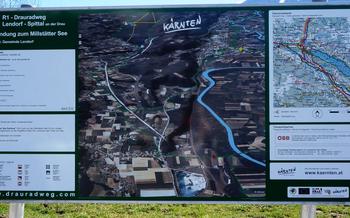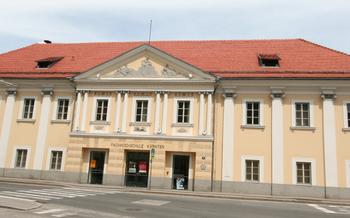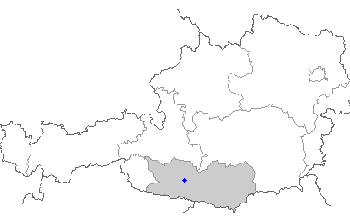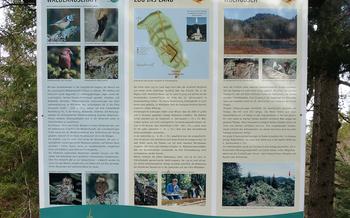
Finkensteiner Moor
- Finkensteiner Moor: A Haven of Biodiversity
- Exploring the Moor on Foot
- A Photographic Paradise
- Birdwatching Haven
- Peat Bogs and Raised Bogs
- The Moor in History
- The Moor in Mythology
- Educational Opportunities
- Accessible for All
- Respecting the Environment
- Best Time to Visit:
- Getting to the Moor
- Local Cuisine and Accommodation
- Insider Tip: Unveiling the Hidden Gem
Finkensteiner Moor: A Haven of Biodiversity
Nestled in the heart of Carinthia, Austria, the Finkensteiner Moor is a remarkable natural reserve that offers a glimpse into the wonders of the wetland ecosystem. With an area spanning over 70 hectares, the moor is a mosaic of diverse habitats, including raised bogs, peat bogs, and reed beds. Its historical significance stems from the fact that the formation of the moor began during the last ice age, making it one of the oldest and best-preserved peat bogs in the Alps. The Finkensteiner Moor harbors a rich array of flora and fauna, including many rare and endangered species. It is a sanctuary for various plants, such as the carnivorous sundew and the rare marsh violet. The moor is also home to a diverse bird population, including several species of waterfowl, waders, and raptors. The conservation efforts at the Finkensteiner Moor are commendable, as the site has been designated as a nature reserve and is actively managed to protect its unique biodiversity.
Exploring the Moor on Foot
The Finkensteiner Moor offers a network of well-maintained hiking trails that allow visitors to explore its diverse landscapes at their own pace. Whether you prefer a leisurely stroll or a challenging hike, there's a trail to suit your needs.
For those who prefer to learn more about the moor's ecology and history, guided tours are available with experienced naturalists. These tours provide insights into the unique flora and fauna of the moor, as well as its conservation efforts.
Along the trails, visitors will encounter scenic viewpoints that offer breathtaking panoramas of the moor's landscapes. These viewpoints provide opportunities to capture the beauty of the natural surroundings, whether it's the vibrant colors of the moorland flowers or the majestic flight of birds.
A Photographic Paradise
The Finkensteiner Moor is a photographer's paradise, offering a kaleidoscope of natural beauty that will captivate your senses. The stunning landscapes, adorned with vibrant flora and fauna, provide a perfect backdrop for capturing breathtaking images. Whether you're a seasoned professional or an enthusiastic amateur, the moor's diverse scenery will inspire your creativity and leave you in awe.
Tips for Capturing the Beauty of the Moor:
Golden Hours: Plan your visit during the golden hours of sunrise and sunset to capture the moor's ethereal glow. The warm, diffused light paints the landscape with a magical aura, enhancing the colors and textures of the surroundings.
Macro Photography: Don't limit yourself to wide-angle shots; explore the moor's intricate details with macro photography. Capture the delicate petals of wildflowers, the intricate patterns on insects, or the glistening dewdrop on a spider's web.
Reflections: Take advantage of the tranquil waters of the moor's ponds and lakes to create stunning reflections. Experiment with different angles and compositions to capture the perfect mirror image of the surrounding landscape.
Wildlife Encounters: Keep your camera ready for wildlife encounters. The moor is home to a variety of birds, amphibians, and insects. Be patient and observant, and you might capture a fleeting moment of wildlife interaction.
Experiment with Filters: Don't be afraid to experiment with filters to enhance your images. Polarizing filters can reduce glare and increase contrast, while neutral density filters can help you capture long exposure shots of the moor's flowing waters.
The Finkensteiner Moor is a haven for photographers, offering endless opportunities to capture the beauty of nature. With its diverse landscapes and rich biodiversity, the moor is a photographer's dream come true.
Birdwatching Haven
The Finkensteiner Moor is a paradise for bird enthusiasts, with over 200 species recorded within its boundaries. The moor's diverse habitats, from open water to wet meadows and dense forests, provide nesting and feeding grounds for a wide range of birds. Some of the most commonly spotted species include the common crane, the Eurasian bittern, the marsh harrier, and the little egret.
Birdwatching hides are strategically positioned throughout the moor, allowing visitors to observe birds without disturbing them. These hides offer comfortable seating and ample space for photography. Guided tours led by expert birdwatchers are also available for those who want to learn more about the moor's avian inhabitants.
For the best birdwatching experience, visit during the spring and summer months when the birds are most active. Bring your binoculars, a camera, and a field guide to help you identify the different species. Be patient and observant, and you'll be rewarded with sightings of some of Europe's most beautiful birds.
Peat Bogs and Raised Bogs
The Finkensteiner Moor is home to various types of bogs, including peat bogs and raised bogs. These unique ecosystems play a crucial role in the moor's biodiversity and ecological balance.
Peat Bogs:
- Peat bogs, also known as ombrotrophic bogs, receive most of their water from rainfall and atmospheric deposition.
- They are characterized by a thick layer of peat, which is made up of partially decayed plant material that accumulates over time.
- The acidic and nutrient-poor conditions in peat bogs support specialized plant communities adapted to these harsh conditions, such as carnivorous plants like sundews and pitcher plants.
Raised Bogs:
- Raised bogs are a type of peat bog that forms on top of a layer of minerotrophic peat, which is derived from groundwater and surface runoff.
- They are characterized by a dome-shaped profile, with a central area that is higher than the surrounding landscape.
- Raised bogs support a diverse array of plant species, including various mosses, sedges, and shrubs. They also provide a habitat for numerous bird species and other wildlife.
The conservation and preservation of these bogs are critical for maintaining the ecological integrity of the Finkensteiner Moor. Ongoing efforts are focused on protecting these unique ecosystems and ensuring their long-term survival.
The Moor in History
The Finkensteiner Moor holds significant historical importance, reflecting the interplay between humans and nature over the centuries. Peat cutting, a traditional activity in the region, has left its mark on the landscape, creating unique patterns and shaping the moor's ecosystems. Peat, a valuable fuel source, was extracted from the bog for centuries, providing heating and cooking fuel for local communities.
In addition to peat cutting, the moor has also been utilized for grazing livestock, particularly cattle and horses. The nutrient-rich grasses of the moorland provided sustenance for these animals, contributing to the livelihoods of local farmers. The traditional practices of peat cutting and grazing have left a lasting impact on the moor's ecology, creating a mosaic of habitats that support a diverse array of plant and animal life.
Moreover, the moor has served as a source of inspiration and wonder, captivating the imaginations of artists, writers, and naturalists alike. Its unique beauty and biodiversity have attracted visitors from afar, who come to witness the changing colors of the seasons, the abundance of wildlife, and the serene tranquility that permeates the air.
The Moor in Mythology
The Finkensteiner Moor is steeped in ancient legends and folklore, adding a mystical dimension to its natural beauty. Myths and tales have been passed down through generations, weaving a rich tapestry of cultural heritage around the moor.
One popular legend tells of a water nymph who dwells in the depths of the moor, luring unsuspecting wanderers with her enchanting songs. Another tale speaks of a hidden treasure buried beneath the peat bogs, guarded by a fierce dragon. These stories, though fantastical, reflect the deep connection between the local communities and the moor, showcasing its significance in their cultural identity.
Storytelling plays a vital role in preserving the moor's heritage. Local storytellers and guides often share these legends and myths with visitors, bringing the moor's past to life. These tales not only entertain but also provide insights into the region's history, traditions, and beliefs.
By embracing the moor's mythological aspects, visitors can gain a deeper appreciation for its cultural significance and the profound bond between the people and their natural surroundings.
Educational Opportunities
The Finkensteiner Moor offers a wealth of educational opportunities for visitors of all ages. Guided tours led by experienced naturalists provide an in-depth look into the moor's ecology, history, and cultural significance. These tours are a fantastic way to learn about the unique flora and fauna that call the moor home, as well as the conservation efforts underway to protect this fragile ecosystem.
In addition to guided tours, the visitor center features interactive exhibits that bring the moor's story to life. These exhibits cover a wide range of topics, including the formation of peat bogs, the history of peat cutting, and the importance of biodiversity. Visitors can also learn about the cultural heritage of the moor through displays on local legends and folklore.
Whether you're a student, a nature enthusiast, or simply someone who wants to learn more about the fascinating world of peat bogs, the Finkensteiner Moor has something to offer. The educational opportunities available here make it an ideal destination for anyone looking to explore the natural world and gain a deeper understanding of the importance of conservation.
Accessible for All
The Finkensteiner Moor is committed to ensuring that everyone has the opportunity to experience its natural wonders. To this end, the moor features a network of wheelchair-accessible trails, allowing visitors with disabilities to explore the beauty of the landscape. These trails are designed with smooth surfaces and gentle slopes, making them easy to navigate for those with limited mobility. Additionally, the visitor center is fully accessible, with ramps, wide doorways, and accessible restrooms. For those who need assistance, guided tours with trained naturalists are available upon request. These guides can provide personalized assistance and ensure that everyone has a safe and enjoyable experience. By creating an inclusive environment, the Finkensteiner Moor demonstrates its commitment to welcoming visitors from all abilities and backgrounds.
Respecting the Environment
As a responsible traveler, it is crucial to minimize your impact on the delicate ecosystem of the Finkensteiner Moor. Adhering to the principles of Leave No Trace ensures that the pristine beauty of the moor remains undisturbed for generations to come. Refrain from picking flowers, disturbing wildlife, or leaving any trash behind. Stay on designated trails to prevent trampling sensitive vegetation and disrupting wildlife habitats. By embracing responsible tourism practices, you contribute to the preservation of this unique natural treasure.
Best Time to Visit:
The allure of the Finkensteiner Moor shifts with the seasons, offering distinct experiences throughout the year. While the spring awakens the moor to life, with vibrant wildflowers blooming and birdsong filling the air, summer brings warm days ideal for hiking and exploring the lush greenery.
Autumn, with its fiery foliage and crisp air, paints a mesmerizing picture, while winter transforms the landscape into a snowy wonderland, perfect for snowshoeing and cross-country skiing.
For bird enthusiasts, the best time to visit is during the spring and fall migrations, when a variety of species can be spotted. However, the moor's resident birds are present throughout the year, offering year-round opportunities for birdwatching.
No matter the season, the Finkensteiner Moor offers a unique and captivating experience, where visitors can immerse themselves in the beauty of nature and connect with the rich biodiversity that calls this special place home.
Getting to the Moor
Reaching the Finkensteiner Moor is a simple and straightforward journey. Whether you prefer the convenience of public transportation or the flexibility of driving, there are options available to suit every traveler's needs.
Public Transportation:
For those seeking a hassle-free travel experience, public transportation is an excellent choice. Regular bus services connect Spittal an der Drau with the moor, ensuring easy accessibility. The bus stop is conveniently located near the entrance, allowing you to seamlessly transition from the urban landscape to the tranquil embrace of nature.
Driving Directions:
If you prefer the freedom and flexibility of driving, the moor is easily accessible by car. From Spittal an der Drau, follow the signs towards Lendorf and then to the village of Laastadt. From Laastadt, follow the road that leads directly to the Finkensteiner Moor. Ample parking spaces are available for visitors, ensuring a convenient and stress-free arrival.
Parking Facilities:
The moor provides ample parking spaces for visitors, ensuring a convenient and stress-free arrival. The parking area is located near the entrance, allowing you to quickly embark on your exploration of this natural wonder.
Local Cuisine and Accommodation
When visiting the Finkensteiner Moor, take the opportunity to savor the local cuisine. The region is renowned for its hearty and flavorful dishes, often featuring fresh, locally sourced ingredients. Indulge in traditional Austrian specialties such as "Kärntner Kasnudln" (cheese-filled pasta dumplings) or "Reindling" (a sweet braided bread with poppy seeds).
Accommodation options near the moor range from charming guesthouses to modern hotels, ensuring a comfortable stay for visitors. Immerse yourself in the local culture by opting for a traditional Austrian guesthouse, where you can experience warm hospitality and savor homemade delicacies.
Supporting local businesses is vital for sustaining the vibrant community surrounding the moor. Choose to dine at local restaurants and stay in family-run guesthouses to contribute directly to the local economy. This not only ensures a more authentic experience but also helps preserve the region's unique character.
Insider Tip: Unveiling the Hidden Gem
Amidst the vast expanse of the Finkensteiner Moor, tucked away from the main trails, lies a hidden gem that few visitors know about. It's a secluded pond, surrounded by an enchanting forest, where nature's tranquility reigns supreme. The water's surface mirrors the surrounding trees, creating a picturesque reflection that invites contemplation.
This secret spot is a haven for photographers, who can capture the beauty of the untouched wilderness. As the sun dips below the horizon, the pond transforms into a magical canvas, painted with vibrant hues of orange and purple. It's a perfect place to witness the sunset, as the sky ignites with colors that seem to dance upon the water's surface.
For those seeking a serene escape, this hidden pond offers a sanctuary of peace and solitude. Whether you choose to meditate, read a book, or simply soak in the beauty of your surroundings, the pond's tranquil atmosphere will leave you feeling refreshed and rejuvenated.
To find this hidden gem, follow the main trail until you reach a small wooden bridge. Cross the bridge and continue along the path, keeping an eye out for a narrow footpath that branches off to the left. Follow this path for a short distance, and you'll be rewarded with the sight of the secluded pond.
Remember to tread lightly and respect the fragile ecosystem as you explore this hidden paradise. Leave no trace of your visit, and let the beauty of nature remain undisturbed for future generations to appreciate.
